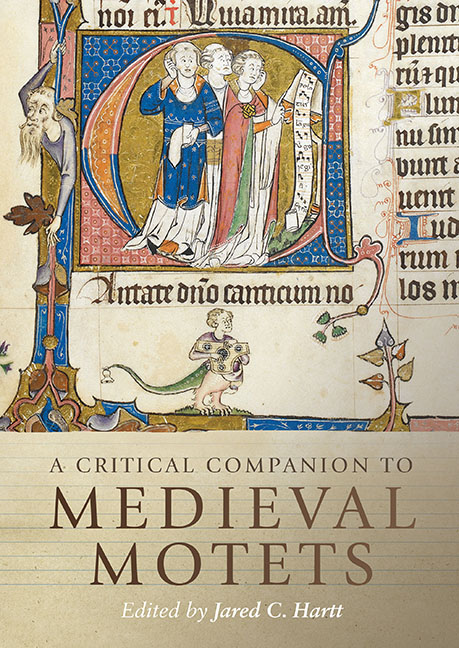Book contents
- Frontmatter
- Dedication
- Contents
- List of Figures
- List of Music Examples
- List of Tables
- List of Contributors
- Preface
- Acknowledgments
- Abbreviations
- Introduction: Approaching Medieval Motets
- 1 The Genre(s) of Medieval Motets
- 2 Origins and Interactions: Clausula, Motet, Conductus
- 3 Tracing the Tenor in Medieval Motets
- 4 Isorhythm
- 5 Notation
- 6 Thirteenth-Century Motet Functions: Views through the Lens of the Portare Motet Family
- 7 A Prism of its Time: Social Functions of the Motet in Fourteenth-Century France
- 8 Motets, Manuscript Culture, Mise-en-page
- 9 Clerics, Courtiers, and the Vernacular Two-Voice Motet: The Case of Fines amouretes / Fiat and the Roman de la poire
- 10 When Words Converge and Meanings Diverge: Counterexamples to Polytextuality in the Thirteenth-Century Mote
- 11 Motets in Chansonniers and the Other Culture of the French Thirteenth-Century Motet
- 12 Building a Motet around Quoted Material: Textual and Musical Structure in Motets Based on Monophonic Songs
- 13 The Duet Motet in England: Genre, Tonal Coherence, Reconstruction
- 14 Materia Matters: Reconstructing Colla/Bona
- 15 Machaut’s Motet 10 and its Interconnections
- 16 A Motet Conceived in Troubled Times: Machaut’s Motet 22
- 17 A Motet Ahead of its Time? The Curious Case of Portio nature/Ida capillorum
- Bibliography of Works Cited
- Select Glossary
- Index of Cited Motets
- General Index
- Studies in Medieval and Renaissance Music
4 - Isorhythm
Published online by Cambridge University Press: 21 October 2020
- Frontmatter
- Dedication
- Contents
- List of Figures
- List of Music Examples
- List of Tables
- List of Contributors
- Preface
- Acknowledgments
- Abbreviations
- Introduction: Approaching Medieval Motets
- 1 The Genre(s) of Medieval Motets
- 2 Origins and Interactions: Clausula, Motet, Conductus
- 3 Tracing the Tenor in Medieval Motets
- 4 Isorhythm
- 5 Notation
- 6 Thirteenth-Century Motet Functions: Views through the Lens of the Portare Motet Family
- 7 A Prism of its Time: Social Functions of the Motet in Fourteenth-Century France
- 8 Motets, Manuscript Culture, Mise-en-page
- 9 Clerics, Courtiers, and the Vernacular Two-Voice Motet: The Case of Fines amouretes / Fiat and the Roman de la poire
- 10 When Words Converge and Meanings Diverge: Counterexamples to Polytextuality in the Thirteenth-Century Mote
- 11 Motets in Chansonniers and the Other Culture of the French Thirteenth-Century Motet
- 12 Building a Motet around Quoted Material: Textual and Musical Structure in Motets Based on Monophonic Songs
- 13 The Duet Motet in England: Genre, Tonal Coherence, Reconstruction
- 14 Materia Matters: Reconstructing Colla/Bona
- 15 Machaut’s Motet 10 and its Interconnections
- 16 A Motet Conceived in Troubled Times: Machaut’s Motet 22
- 17 A Motet Ahead of its Time? The Curious Case of Portio nature/Ida capillorum
- Bibliography of Works Cited
- Select Glossary
- Index of Cited Motets
- General Index
- Studies in Medieval and Renaissance Music
Summary
Son plaisir consiste à inventorièr les manieres possibles de traiter une matière donnée.
SCHOLARS TODAY generally agree that ‘isorhythm’ ought to mean what it says, a term describing segments of music literally exhibiting the ‘same rhythm’, duration for duration. This is the lesson of Margaret Bent's influential 2008 article ‘What is Isorhythm?’ By then, the literal sense of the term had already been normal usage in the work of many scholars, including, besides Bent herself, Ernest Sanders and Daniel Leech-Wilkinson. As a designation of genre, however, ‘the isorhythmic motet’, a looser and vastly more inclusive usage was still generally accepted, and Bent's call for strict consistency between the nominal and adjectival forms of the term effectively limits its application as a generic designation to a small and incohesive assemblage of works, leaving the category without historical relevance. As compensation for a focused reinterpretation of this and many other terms, Bent offers a new terminological precision capable of distinguishing procedures that had been wrongly grouped together in earlier analyses (an example is the sphere of possibilities that had been subsumed under the term ‘diminution’), thereby celebrating a newly revealed diversity of compositional procedures that had not been sufficiently appreciated previously.
Friedrich Ludwig, who coined the term in the early twentieth century, pursued a more general goal: to write a synthetic account of a period of music history. The discovery of the Ivrea codex (Iv) in 1921, which added a number of new motets to the repertory, allowed Ludwig's student Heinrich Besseler to flesh out a detailed narrative. For Besseler, the style of motet pioneered by Philippe de Vitry was an innovation that not only swept away the enormous diversity of late thirteenth-century motet types in France, but also, in its essentials, remained dominant for well over one hundred years, from c. 1316 up to the late motets of Guillaume Du Fay in the 1440s. This broader narrative recedes in Bent's sharpened critical perspective, despite the probability that Philippe de Vitry would have recognized Du Fay's Nuper rosarum flores as a motet. In my revised account, Vitry still figures as the key player, though the point of departure for this episode in music history depends more on literary factors than musical ones.
- Type
- Chapter
- Information
- A Critical Companion to Medieval Motets , pp. 77 - 102Publisher: Boydell & BrewerPrint publication year: 2018



